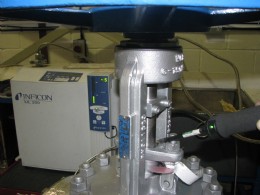Cryogenic Masterclass

.jpg)

Gate Valve Fugitive Emissions Test
The process of testing a valve at Cryogenic temperatures is a complex one. Firstly, the correct size of cold box must be used to ensure the amount of cooling media required is minimised. The valve can then take several hours to cool to the required test temperature. The actual process of testing the valve can often be relatively short, sometimes only 15-30 minutes, depending on client specification.
Valves can be tested for low temperature suitability for two reasons. Firstly, valves that are intended to operate with low temperature or cryogenic media, such as LNG or liquefied gases such as Oxygen and Nitrogen. The second category covers valves that can see extreme external temperatures. We regularly test valves destined for the Karachaganak project in Kazakhstan where ambient temperatures can drop to below -40 degrees C. Whatever the reason the basic purpose of the test is to ensure that the valve functions correctly at low temperature and to detect any leakages, either fugitive emissions or in-line leaks. The leakages are discovered using a piece of equipment called a Mass Spectrometer. The Mass Spectrometer probe detects minute quantities of escaping gases from the valve body. Any seat leakage is monitored using flow meters on our test manifold.
The standard choice of test gas tends to be Helium, or Nitrogen with a trace of Helium. Hydrocarbons are not a feasible option given the potential for explosions. Itís also essential that the valve is cleaned prior to testing as the Mass Spectrometer is a very sensitive piece of equipment, and any contaminants could give a false reading or possibly damage the equipment.
Test results are obviously classified but in our experience the main reason valves fail test is incorrect specification. Valves are often manufactured correctly but the soft seals may not be suitable to perform at low temperatures. A residue of Hydrostatic test fluid in the valve can also cause a problem as ice can form on the seats which prevents operation of the valve. Therefore, when ordering valves required for use at low temperatures, ensure the valve is properly cleaned prior to test.
Adanac standard procedure for testing valves at low temperature is to firstly subject the valve to an ambient pressure test. Any leakage issues are quickly revealed, enabling corrective measures to be taken before the more costly low temperature test is done.
Leakage through the gland could often be attributed to the packing itself, or even the parallelism of the stem. Even a slight taper on the stem can open up the packing, creating leak paths. Finding suitable materials for gland packing is not an exact science. For example, materials that perform well at ambient temperatures may not be suitable for low temperature applications. Selection of suitable gland packing material is dependent upon the application. Adanac have found solutions in both bespoke seal manufacture, the use of particular proprietary products or a combination of both.
In summary, manufacturing valves suitable to operate at Cryogenic temperatures is a complex process, but correct material specification, accurate machining processes and suitable valve cleanliness all play an important part in the efficient performance of any valve required to operate in such applications.
Adanac Valve Specialities
Tel: 01359 240 404
www.adanac.co.uk

| Telephone: | 01359 240 404 |
| Email: | sales@adanac.co.uk |
| Website: | www.adanac.co.uk |
| More information on the Adanac Valve Specialities BVAA Member Directory Page |
Search related valve / actuator articles: Adanac Valve SpecialitiesIssue 23Cryogenic ValvesMaster Class











